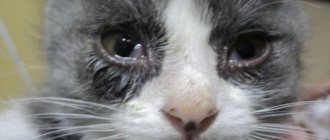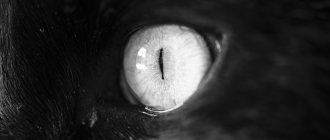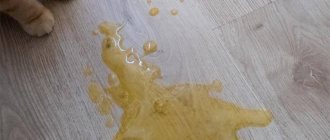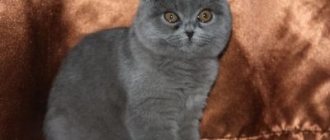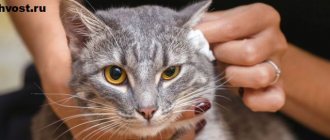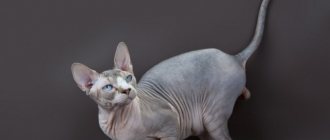Eye diseases in pets are not uncommon. It is important for the owner of the animal to find out why the kitten’s eyes are festering, how to treat the inflammation and how to properly treat the eyelids so that the disease recedes faster. If you notice redness, swelling of the eyes or watery eyes in your pet, you should not hesitate. Lack of treatment can result in damage to the cornea or even loss of vision.
The kitten has conjunctivitis
Suppuration: normal or pathological?
Eye discharge does not always appear due to pathological processes developing in the body.
In some cases, pus in a cat accumulates under the eyelids for the following reasons:
- weakened immune system;
- improperly selected diet (lack of nutrients);
- infectious, viral damage;
- unsanitary conditions when keeping animals;
- draft;
- eye injuries;
- allergic reaction to household chemicals, perfumes;
- inflammatory processes in the cornea (keratitis);
- dust in the room where the pet is kept.
On a note! If the discharge is abundant and prolonged, you should not resort to self-medication; the animal must be taken for examination to a veterinary clinic, where the doctor will determine the cause and prescribe adequate treatment.
The owner should pay attention to the color of the discharge. Rare discharge of a grayish tint is normal, and thick discharge of a yellowish or green tint most likely indicates the development of pathological processes in the body.
Species susceptibility
The breeds that are most often susceptible to purulent inflammation of the conjunctiva include:
- Scottish - due to the anatomical features of the muzzle (the lacrimal gland duct is shortened), frequent lacrimation causes the wool to get wet and become soaked, which creates a favorable environment for inflammation;
- British - facial features similar to the Scottish breed and a tendency to allergic reactions;
- Persian - a modified nasolacrimal duct due to the peculiar structure of the muzzle;
- Himalayan and Burmese - for them eye diseases are hereditary;
- Sphynx - low resistance to hypothermia and the absence of fur around the eyes, which performs a protective function.
Suppuration: 5 main reasons
The main reasons for the appearance of pus:
- Thick, yellow pus is a sign of an infectious, viral, or fungal disease. The cause of this symptomatology is bacteria or viruses that have entered the animal’s body. Associated symptoms: increased body temperature, apathy, refusal to eat, matted fur around the eyes.
- Cold. If a kitten has a cold, purulent discharge can serve as one of the symptoms of a cold, additional symptoms: sneezing, mucus discharge from the nasal passages, lethargy, chills.
- Ophthalmological diseases. Pathologies of the eyelids, inflammation of the cornea, conjunctiva, blepharitis can become the reason due to which suppuration begins on the organs of vision.
- Allergic reaction. Pus can be released if the animal is allergic to food, household chemicals, perfumes, or pollen.
- In case of mechanical damage to the eye, the wound may become infected, in these cases pus will begin to ooze from the organ of vision.
Be sure to read:
The kitten sleeps constantly: physiological and pathological reasons, what affects when to sound the alarm
Why do kitten eyes fester?
Before you begin treating your kitten, it is important to identify why the kitten’s eyes are purulent. All the main reasons can be divided into two groups:
- Mechanical reasons. These can be wounds, specks, bruises, eyelid inversions and many other harmless phenomena. Newborns can involuntarily injure each other with small claws, fall out of the bed, and so on. If renovation work is going on in the house, clouds of dust rise up in the room, which get into the eyes and cause inflammation. Tobacco smoke works on the same principle. Older cats begin to lead an active lifestyle: they play and fight. Entertainment becomes the main cause of scratches and various injuries.
- Diseases. Viral infections, conjunctivitis, chlamydia, blepharitis, allergies and much more. They are transmitted from the mother, through milk, or acquired through improper care and feeding. Stray cats are more likely than domestic cats to have viral diseases of the eyeballs.
Reference. British scientists have concluded that conjunctivitis in one third of kittens is caused by chlamydia. The viral disease occurs in furry fidgets aged 1 to 9 months. Chlamydia is transmitted to healthy kittens by contact from infected kittens.
What can you do before visiting a doctor?
If there is heavy discharge, do not put off going to the veterinarian. Before going to the veterinary clinic, you can relieve your pet's condition by rinsing the eyes yourself.
Until the causes of the disease are determined and adequate therapy is prescribed, the following should be used:
- weak solution of potassium permanganate,
- herbal infusion,
- decoction of tea leaves.
Any of the above products must be cooled to room temperature.
How to carry out the procedure:
- Calm the animal, secure the paws with a towel, wrap the entire body, and lay it on its side.
- Use a pipette or syringe without a needle to drip warm boiled water onto your eyes to soften dried discharge, and gently wipe your eyelids with a swab.
- Moisten 2 cosmetic discs generously in the solution, wipe each eye with a separate disc.
On a note! To avoid infection in a healthy organ of vision, you should take a new cotton pad after each wiping; repeated use is unacceptable.
During treatment, do not bring the syringe or pipette close to the eyes; the kitten may twitch, which will lead to mechanical injury. Processing is carried out from the outer corner towards the inner.
Health Hazard
Discharge from the eyes is a clear sign that indicates the presence of an infection in the body. Ignoring the first symptoms and untimely treatment can negatively affect the body of a small pet. Without treatment, it can lead to complete loss of vision.
Attention! Pus is normal for newborns. However, greenish or light gray discharge with a strong unpleasant odor indicates serious problems in the body. You should contact your veterinarian as soon as possible.
Suppuration with a runny nose, what to do
Eye discharge accompanied by chills, sneezing, and snot most often indicate a runny nose. For a fragile body, a runny nose can serve as an impetus for the development of serious diseases, such as viral rhinotracheitis or calcivirosis.
If you suspect the development of the disease, you should take the animal to a veterinary clinic, where a doctor will examine it, prescribe tests and a treatment regimen.
Medicines that are most often prescribed for colds to treat suppuration:
- anti-inflammatory drugs,
- antibiotics,
- immunomodulators.
Possible complications
If you refuse to visit the clinic and choose medications for your pet on your own, the disease takes on an advanced form and is dangerous due to its relapses. Fungal and parasitic skin lesions (mainly on the head) are possible, worsening the pet’s condition.
With an advanced form of infectious diseases and a kitten’s weak immunity, the pet will not be able to survive.
With eye disease and unqualified assistance, the damage affects the deep layers of the eye. In this case, the pet faces loss of vision.
What drops and ointments to use
For ocular discharge, veterinarians advise using various ointments and drops for treatment. In order for the drug to be beneficial, the owner must follow a number of rules.
How to instill drops:
- Pre-rinse the eye mucosa with herbal decoction or tea leaves.
- Secure the pet and lay it on its side.
- Pipette drops at room temperature.
- Gently drip into outer corners.
- Remove residues with a dry cotton pad.
Be sure to read:
What to do if pus comes out of your cat’s nose, what could it be, should you be afraid?
How to apply the ointment:
- Warm the prescribed drug in your palms to room temperature.
- Secure the pet with a towel and lay it on its side.
- With clean hands, place the ointment under the lower eyelids, pulling them slightly.
- Massage the eyelids with the ointment for a few seconds.
- Rub the treated eyes with a dry cotton swab to remove excess.
Commonly prescribed ointments:
- tetracycline eye ointment,
- hydrocortisone,
- solcoseryl.
Popular drops:
- albucid,
- gentamicin drops,
- veterinary drops “Iris”, “Bars”, “Diamond Eyes”,
- levomecithin drops.
Prevention
To prevent your kitten from suffering from conjunctivitis and other eye diseases, you need to keep your eyes clean every day. To do this, use regular saline solution or boiled water. Using a damp cotton pad, gently remove dirt from the eyelids.
It is very important to maintain your pet's immunity. The diet should be varied. The cat's menu includes not only meat, but also vegetables, fermented milk products, and quail eggs. You should protect your four-legged friend from contact with stray animals, as they often suffer from various infections. Vaccination will help prevent infection with dangerous diseases.
If your kitten's eyes are swollen and red, the first thing to do is take him to the vet and find out what is causing the problem. He will prescribe treatment after diagnosis. In most cases, you can get rid of conjunctivitis within a week if you follow all the doctor’s recommendations.
How to treat at home
At home, you can try to get rid of pus by regularly treating the mucous membranes of the eyes with a solution of furatsilin, a decoction of medicinal herbs.
It is not advisable to use eye drops purchased at a pharmacy without a prescription from a veterinarian. A dosage suitable for humans can lead to serious consequences if used on a kitten.
You can put tetracycline eye ointment under the patient's lower eyelids.
If the kitten’s condition does not improve 2-3 days after the start of treatment, a visit to the veterinary clinic should be made.
Cautions
If the disease is serious, you cannot do without consulting a veterinarian. Only a specialist can prescribe appropriate medications and procedures based on your medical history and test results.
Otherwise - if street dust gets into the cat's eyes, for example - you can do a simple cleansing yourself. But remember a few important rules:
Not all water can be used for this.
There is definitely no tap water - the bleach and salts contained in it dry out the mucous membrane and destroy the natural microflora. In addition, such water may be contaminated. Rain and melt water are also not suitable. The liquid must be boiled and cooled!- Instead of cotton wool, use cotton pads: this is the only way to be sure that small fibers will not get under the eyelid and cause additional problems.
- For each eye - a new tampon, for each procedure - a fresh decoction.
- You cannot use chamomile infusion - it causes cats to lose hair.
- Rinse solutions should be warm, not hot or cold.
- If days go by and there is still no result, take your cat to the doctor.
Folk remedies
At home, for rinsing, it is recommended to use infusions, solutions, and decoctions prepared on the basis of medicinal herbs.
- Rinse with saline solution.
Add half a teaspoon of table salt to 500 ml of chilled boiled water and stir thoroughly. Rinse eyes 2-3 times a day with cotton pads. Do not use if the condition is caused by an allergen entering the body.
- Treatment with herbal infusion.
Prepare a mixture of dried herbs (calendula, sage) at a ratio of one to one. Pour a couple of tablespoons of the mixture into 500 ml of cold water, place in a steam bath, cook for 12-15 minutes, strain, cool. Carry out treatment several times a day.
- Washing with tea.
Pour a glass of boiling water over a bag of green tea and let it brew. Rinse the organs of vision in case of mechanical injuries, inflammatory processes to relieve inflammation.
- Treatment with solutions of furatsilin, boric acid.
Be sure to read:
The cat does not drink water: reasons, daily intake, what to do, is it dangerous, how to force the animal to drink
Prepare a solution at the rate of: 2 drops of furatsilin per tablespoon of boiled water or a pinch of boric acid per glass of boiled water. Treat 2 times a day.
Diagnostics
When a kitten’s eye festers, the doctor decides how to treat it. Modern diagnostic procedures do not take much time and do not cause discomfort to the animal.
Before visiting the doctor, it is better not to feed the kitten, as the veterinarian may order a laboratory blood test.
On the day of visiting the clinic, kittens do not wash their eyes - this will blur the overall picture of the discharge and make it difficult to make an accurate diagnosis.
The reasons why a cat’s eye is watery or purulent are determined using the following methods:
- Schirmer's test - determines the amount of tear fluid that is necessary to maintain the natural level of humidity;
- biomicroscopy – studies the condition of the connective membrane, iris, vitreous body, lens;
- measurement of intraocular pressure - the difference between the addition and outflow of moisture is determined;
- Ultrasound – examination of all structures of the organ of vision;
- examination of the optic nerve and retina;
- checking the patency of the nasolacrimal ducts.
Medications
- Hydrocortisone drops with novocaine - to relieve swelling, inflammation, pain.
- Gentamicin drops - for severe inflammatory processes.
- Albucid drops - for the treatment of injuries.
- Drops with chloramphenicol - for infectious lesions.
- Drops with atropine - for the development of photophobia.
- Solcoseryl ointment - for healing mucous membranes in case of injuries.
- Tetracycline ointment for allergic reactions, to relieve inflammation.
Features of the procedure
There are no fundamental differences in washing the eyes of an adult animal or a kitten: the procedure for performing the procedure is almost identical. The difference lies in small nuances that will help your pet as much as possible and not cause harm.
It all starts with preparing the necessary materials - you will need:
- several clean cotton pads or pieces of gauze;
- clean cloth napkins or towel;
- syringe without a needle (for copious rinsing);
- what you will use to wipe your cat’s eyes is a solution or decoction of herbs.
For aggressive or restless animals, a towel is useful - you can wrap the animal in it - or a retaining bag.
In adults
Adult cats may resist, so you will need an assistant to hold and calm the animal. The cat must be wrapped in a towel or blanket to gently hold it and not harm it during the procedure. Once the animal has been secured, you can begin washing.
First you need to soak the dried crusts, if any. After dipping a cotton pad into the medicinal solution, you need to squeeze the product into the sore eye and wait until the crusts become softer and easier to remove. Gently wipe the disc over the eyelid, being careful not to touch the cornea. Movements should be directed from the ears to the nose, towards the tear duct. Use different pads on different eyes to avoid infection of the healthy eye.
Once the eyes are clean, pour the medicinal solution onto the cornea of the eye using a syringe without a needle - if required by treatment. Normal hygienic cleaning can be left without this step. Remove any remaining solution around the eyelids with a dry cloth or towel. Do not press and try not to touch the eyeball with the tissue so as not to injure it or cause irritation.
How to wash a kitten's eyes
Kittens do not always cope well with washing themselves, as they are accustomed to the mother cat taking care of hygiene. In the first few months, the owner needs to regularly wash the baby’s eyes so that they do not begin to stick together and fester.
The whole manipulation is almost identical to what is done for an adult cat. However, the procedure should be performed with extreme caution so as not to harm the small pet. You can do without an assistant - you can handle the baby yourself, especially if he is still sleepy. But after eating, you should not carry out the procedure - the kitten may vomit.
If, in addition to rinsing, there is a need to instill medicinal solutions or apply ointments, then precautions should be taken. Unlike adult cats, kittens should not have medicinal solutions put into their eyes immediately after rinsing: you must wait about ten minutes to minimize the risk of irritation.
If you have never owned a cat and do not know how and what to wash a kitten’s eyes with, contact your nearest veterinary clinic or an experienced breeder. You will quickly be shown all the steps of this easy and simple procedure.
Conjunctival dystrophy
Pinguecula (wen)
Pinguecula is a limited thickening of the conjunctiva that appears in the area of the inner edge of the cornea.
It occurs in older people as a result of eye irritation by external factors. The pathology may look like a small cosmetic defect. Removed in rare cases, at the request of the patient.
Pterygium
Pterygium (or pterygoid pleura) is an analogue of the mucous membrane of the eyeball, has a triangular shape and grows into the surface of the cornea from the side of the nose. The reason is mechanical, chemical irritants, long exposure to the sun without dark glasses.
The non-progressive form of pterygium does not require surgical treatment.
The progressive form of the pterygoid pleura begins to grow towards the center of the eye. Due to this growth, the following symptoms appear: redness and irritation of the eye, watery eyes, decreased vision due to astigmatism. In such a situation, surgery is necessary.
1 Diagnosis and treatment of conjunctivitis
2 Diagnosis and treatment of conjunctivitis
3 Treatment of conjunctivitis
Dry eye syndrome
Dry eye syndrome is a violation of the wetting of the surface of the eye due to changes in the quantity and quality of tear fluid, as well as rapid evaporation of the tear film.
Our eye is protected by an ultra-thin, three-layer tear film. The top oily layer allows the upper eyelid to glide over the surface of the eye and prevents the other two layers from drying out.
The middle layer (aqueous, with electrolytes) supplies the cornea with nutrients, protects the eye and flushes foreign bodies out of it.
The third mucin layer ensures the smooth surface of the cornea and maintains clear vision. Violation of the stability of the tear film leads to dryness of the surface of the conjunctiva and cornea and the appearance of dry eye syndrome.
This pathology is called the “disease of civilization”, since long hours of work at the computer, unhumidified air from air conditioners and prolonged wearing of contact lenses greatly contribute to the appearance of the disease.
Other causes of dry eye syndrome can be: endocrine disorders, pathology of the visual organs, connective tissue diseases, vitamin deficiency, and the use of certain medications.
Symptoms of dry eye syndrome:
The following signs of dry eye syndrome can be identified:
- feeling of sand in the eyes, dryness and pain (may increase at the end of the day);
- redness of the eyes;
- blurred vision that disappears when blinking;
- eye discomfort after reading or working at the computer.

